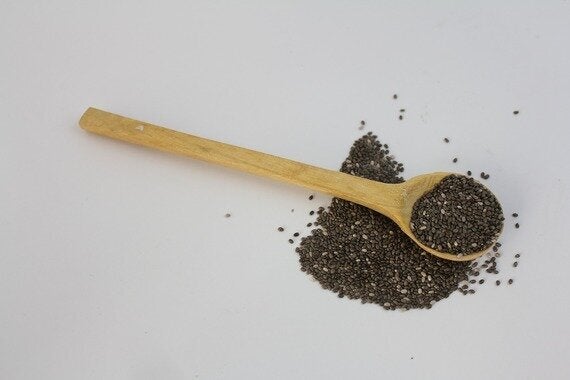
(Image: pixabay.com)
Chia seeds have exploded in popularity among the health conscious of us, as they have become increasingly well-known and promoted by enthusiasts and influencers. They have numerous nutritional benefits, but it's the adverse effects that tend to get left out in the promotion of chia! I aim to cover the good, the bad and the less pretty facets of chia, right here, in this article. First, let's look a little closer at these little seeds.
Chia Seeds
'Salvia hispanica', commonly known as chia, is a species of flowering plant in the mint family, Lamiaceae, native to central and southern Mexico and Guatemala' (United States Department of Agriculture. 2000)
In past times, the seeds were highly valued for their medicinal properties and nutritional value - Aztec warriors were said to have eaten chia seeds to give them high energy and endurance. These seeds are an unprocessed, whole food known to be packed full of antioxidants, fibre, omega-3's and proteins. A 100-gram serving of chia seeds is a rich source of B vitamins, thiamine, and niacin (over half of your daily requirement) and a good source of riboflavin and folate. The same amount of chia seeds is also a rich source of the dietary minerals calcium, iron, magnesium, manganese, phosphorus, and zinc (all, more than 20% of your daily need).
They have a mild and nutty flavour and can be sprinkled on top or mixed into many food dishes or beverages. When added to water or other liquids, the seeds develop a gel type coating and the seed can absorb up to 12 times it's body weight in water!
It's worth noting that, you can buy whole seeds, chia bran, ground chia or even chia seed oil to use in your recipes.
The Good
Fantastic energy boosters
Low carb, high fibre food.
They absorb 12 times their weight in water, expanding in the stomach, causing you to feel fuller due to the slow absorption and leading you to consume less calories as a result
High in good quality protein and amino acids (great for vegetarians and vegans)
High in omega-3's - great if you're not getting plenty of fish
High in bone health nutrients: calcium, phosphorus, magnesium and protein.
Help prevent metabolic disorders like dyslipidemia (excessive fat in the blood) and insulin resistance - two factors in the development of diabetes.
Reduces blood pressure
Anti-inflammatory
Regulate cholesterol
Can be eaten raw or cooked
Can be used as an egg substitute in cooking (good for those with egg allergies)

(Image: pixabay.com)
The Bad & The Ugly
By absorbing a lot of water, these seeds can keep you fuller for longer, great right? Yes, however... remaining hydrated is absolutely essential when eating chia seeds. It is necessary to drink at least double the water you would usually consume, in order to avoid very uncomfortable digestive issues such as bloating, stomach cramps and other symptoms associated with developing 'blockages'
Excessive intestinal gas - no one wants that!
Allergies are uncommon but symptoms linked might include; rashes, watery eyes and hives as a member of the salvia family if you are allergic to mustard, sesame or sage then be wary of chia seeds.
Sometime you might consume more chia seeds than your body can tolerate, especially if consuming everyday in different varying amounts.
If you are new to chia seeds it is best to start by soaking them first so that the water absorbing process happens outside the body enabling it to then cleanse the system inside.
Whole chia seeds can sometimes get stuck in the intestinal lining, causing discomfort and bloating, although in theory they are cleansing the system and getting into every nook & cranny this also can be uncomfortable whilst it occurs. If not drinking enough water then sometimes blockages occur and those who consider constipation, diarrhea or toilet talk a sensitive subject should be aware that chia seeds can play an unwanted roll for a couple of days.
Nobody likes feeling toxic, nauseous, headaches, hot or cold but generally chia seeds can make you feel this quite innocently as they are doing their job; to chuck out toxins. Again the best thing you can do is to drink lots of water to help flush everything out. Lemons, ginger and olives can help with nausea symptoms.
Finally, it should be noted that chia seeds can lower your blood pressure. This is a great benefit to many although those taking any medication for low blood pressure can experience interference with their medication. http://www.bustle.com/articles/88621-5-chia-seed-side-effects-that-you-probably-were-not-aware-of-because-its-possible-to
Try this:
Soak chia seeds BEFORE eating, at least 2-8 hours or overnight. Check there is a "gel-like" substance before consuming.
Not got time to wait? Grind the chia seeds & mix into your breakfast or morning liquids (juice or smoothie), in a few minutes you will have a gel like paste or thickness.
If you drink 1.5 litres a day, aim for 3 litres - if you cannot face all that water opt for vegetable based juices with watery produce such as celery, cucumber, fennel, apple, pear, lemons and ginger.
I prefer to use them in milled/ground form - I mill my own in a high speed blender and store in a glass jar in the fridge. This storage method is important as milled seeds will otherwise oxidise when no longer whole.
Chia seeds are clearly, a fantastic source of nutrients however it is, as always, about careful responsible consumption that is moderate - with plenty of water!